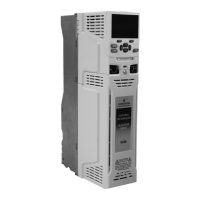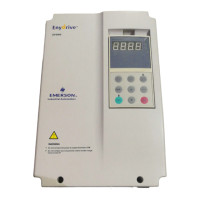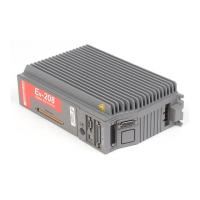Safety
information
Product
information
Mechanical
installation
Electrical
installation
Getting
started
User Menu A Commissioning
Advanced
Parameters
Diagnostics Optimization CT MODBUS RTU Technical Data
204 E300 Design Guide
Issue Number: 1
The following describes the effects of the auto-tune test on the drive parameters for RFC-S mode:
1. All auto-tune tests rely on the motor being stationary when the test is initiated to give accurate results.
2. When each stage of the test is completed, the results written to the appropriate parameters and these parameters saved in the drive non-volatile
memory. If Parameter Cloning (N01) is set to 3 or 4 the parameters are also written to a non-volatile media card fitted in the drive.
The table below shows the parameters required for motor control indicating which should be set by the user and which can be measured with an auto-
tune test.
Auto-tune test 1: Stationary test for basic control parameters
This test can be used to measure all the necessary parameters for basic control. (This test is not likely to give such an accurate value for Position
Feedback Phase Angle (C13) as auto-tune test 2.
1. A stationary test is performed to locate the flux axis of the motor.
2. If sensorless mode is not selected then Position Feedback Phase Angle (C13) is set up for the position from the position feedback interface.
3. A stationary test is performed to measure Transient Inductance Ld (B33) and No Load Lq (B37).
4. A stationary test is performed to measure Stator Resistance (B34), Maximum Deadtime Compensation (B46) and Current At Maximum Deadtime
Compensation (B47).
5. Stator Resistance (B34) and Transient Inductance Ld (B33) are used to set up Current Controller Kp Gain, Final Current Loop Kp (J29) and Final
Current Loop Ki (J30). This is only performed once during the test, and so the user can make further adjustments to the current controller gains if
required.
It should be noted that because this is a stationary test, it is not possible to check the direction of the position feedback. If the motor power connection
phase sequence is incorrect so that the position feedback counts in reverse when the drive applies a phase sequence U-V-W to operate in the
forward direction then the motor will jump thought 90
o
electrical and stop with a current in the motor defined by the current limits. This can be
corrected by changing the drive output phase sequence with Reverse Motor Phase Sequence (B26) and then repeating the auto-tuning. This will
make the motor rotate correctly in the direction defined by the position feedback rotation. If the position feedback direction is correct the motor will
then rotate under control in the required direction, but if the position feedback direction is incorrect the motor will then rotate under control in the wrong
direction.
Auto-tune test 2: Rotating test for basic control parameters
This test can be used to measure all the necessary parameters for basic control and parameters for cancelling the effects of cogging torque. The
motor must be unloaded for this test. (This test is likely to give a more accurate value for Position Feedback Phase Angle than auto-tune test 1.) Note
that if sensorless mode is selected Auto-tune 1 test is performed.
1. If sensorless mode is not selected then a rotating test is performed to locate the flux axis of the motor and Position Feedback Phase Angle (C13)
is set up for the position from the position feedback interface. This is done by rotating the motor by 2 electrical revolutions (i.e. up to 2 mechanical
revolutions) in the required direction.
2. Steps 3 to 6 of the stationary test above are carried out.
The default value for this parameter depends on the frame size of the drive as follows:
• 3.0 % up to frame size 6 drives
• 2.0 % for frame size 7
Parameter Required for Measured in test
Motor Rated Current (B02) Basic control
Motor Rated Speed (B07) Basic control
Motor Rated Voltage (B03) Basic control
Number Of Motor Poles, Motor Number Of Motor Poles (B05) Basic control
Stator Resistance (B34) Basic control 1, 2
Transient Inductance Ld (B33) Basic control 1, 2
Maximum Deadtime Compensation (B46) Basic control 1, 2
Current At Maximum Deadtime Compensation (B47) Basic control 1, 2
Position Feedback Phase Angle (C13) Basic control with position feedback 1, 2
Current Controller Kp Gain, Final Current Loop Kp (J29) Basic control 1, 2
Final Current Loop Ki (J30) Basic control 1, 2
B12 Low Frequency Voltage Boost
Mode Open-Loop, RFC-A
Minimum 0.0 Maximum 25.0
Default 3.0 Units %
Type 8 Bit User Save Update Rate Background read
Display Format Standard Decimal Places 1
Coding RW, BU

